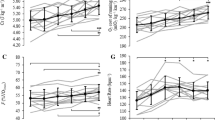Summary
Maximal O2 consumption (\(\dot V_{O_{_2 max} } \) and energy cost of running per unit distance (C) were determined on the treadmill in 36 male amateur runners (17 to 52 years) who had taken part in a marathon (42.195 km) or semi-marathon (21 km), their performance times varying from 149 to 226 and from 84 to 131 min, respectively.\(\dot V_{O_{_2 max} } \) was significantly (2p<0.001) greater in the marathon runners (60.6 vs 52.1 ml · kg−1 · min−1) whileC was the same in both groups (0.179±0.017, S.D., mlO2 · kg−1 · m−1 above resting), and independent of treadmill speed. It can be shown that the maximal theoretical speed in endurance running (vEND) is set by\(\dot V_{O_{_2 max} } \), its maximal sustainable fraction (F), andC, as described by:vEND=F ·\(\dot V_{O_{_2 max} } \) ·C −1. SinceF was estimated from the individual time of performance,vEND could be calculated. The average speed of performance (vMIG) andvEND (m · s−1) were found to be linearly correlated:vMIG=1.12+0.64vEND (r 2=0.72;n=36). The variability ofvMIG explained byvEND, as measured byr 2, is greater than that calculated from any one regression betweenvMIG and\(\dot V_{O_{_2 max} } \) (r 2=0.51),F ·\(\dot V_{O_{_2 max} } \) (r 2=0.58), or\(\dot V_{O_{_2 max} } \) ·C −1 (r 2=0.63). The mean ratio of observed (vMIG) to theoretical (vEND) speeds amounted to 0.947±0.076 and increased to 0.978±0.079 (±S.D.;n=36) when the effects of air resistance were taken into account. It is concluded thatvEND=F ·\(\dot V_{O_{_2 max} } \) ·C −1 is a satisfactory quantitative description of the energetics of endurance running.
Similar content being viewed by others
References
Conley DL, Krahenbuehl GS (1980) Running economy and distance running performance of highly trained athletes. Med Sci Sports Exercise 12:357–360
Costill DL, Branam G, Eddy D, Sparks K (1971) Determinants of marathon running success. Int Z Angew Physiol 29:249–254
Costill DL, Thomason H, Roberts E (1973) Fractional utilisation of aerobic capacity during distance running. Med Sci Sports 5:248–252
Davies CTM (1980) Effects of wind assistance and resistance on the forward motion of a runner. J Appl Physiol 48:702–709
di Prampero PE (1981) Energetics of muscular exercise. Rev Physiol Biochem Pharmacol 89:143–222
di Prampero PE (1986) The energy cost of human locomotion on land and in water. Int J Sports Med (in press)
Margaria R (1938) Sulla fisiologia e specialmente sul consumo energetico della marcia e della corsa a varia velocità ed inclinazione del terreno. Atti Acc Naz Lincei 7:299–368
Margaria R, Cerretelli P, Aghemo P, Sassi G (1963) Energy cost of running J Appl Physiol 18:367–370
Maughan RJ, Leiper JB (1983) Aerobic capacity and fractional utilisation of aerobic capacity in elite and non-elite male and female marathon runners. Eur J Appl Physiol 82:80–87
Menier DR, Pugh LGCE (1968) The relation of oxygen intake and velocity of walking and running in competition walkers. J Physiol (Lond) 197:717–721
Pugh LGCE (1970) Oxygen intake in track and treadmill running with observations on the effect of the air resistance. J Physiol (Lond) 207:823–835
Pugh LGCE (1971) The influence of the wind resistance in running and walking and the mechanical efficiency of work against horizontal forces. J Physiol (Lond) 213:255–276
Saltin B (1973) Oxygen transport by the circulatory system during exercise in man. In: Keul J (ed) Limiting factors of physical performance. Thieme, Stuttgart, pp 235–252
Author information
Authors and Affiliations
Rights and permissions
About this article
Cite this article
di Prampero, P.E., Atchou, G., Brückner, J.C. et al. The energetics of endurance running. Europ. J. Appl. Physiol. 55, 259–266 (1986). https://doi.org/10.1007/BF02343797
Accepted:
Issue Date:
DOI: https://doi.org/10.1007/BF02343797




